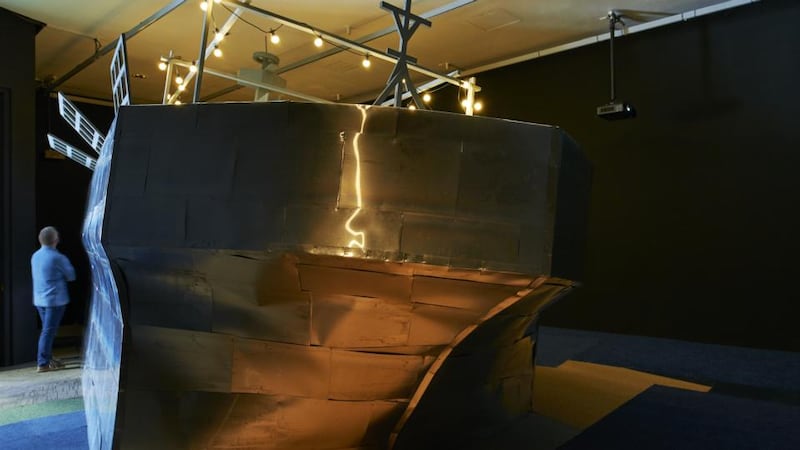When the great earthquake struck off the coast of Tohoku in Japan in March 2011, it unleashed tsunamis that inundated the coast, killed and injured close to 16,000 people and devastated entire towns and infrastructural networks. In the midst of so much death and destruction, the disappearance of the Ryou-Un Maru, a 150-ton squid-fishing boat tied up in harbour at the end of its useful life, was hardly a surprise and not particularly noteworthy. It was assumed that the boat had been swamped by a tsunami and had sunk, and it was written off.
In fact, freed from its moorings, the boat, like much else washed out to sea by the tsunamis, was picked up by the Kuroshio current, also known as the “Black Tide”. A Pacific equivalent of the Gulf Stream, the current flows north along the coast of Japan and then eastwards out into the vastness of the North Pacific.
The Ryou-Un Maru, still intact and buoyant, had become a ghost ship. Carried by the Kuroshio, it made its way gradually across the Pacific until, just over a year later, it was spotted by an aircraft patrolling Canadian waters off the coast of Alaska. But, having been registered as lost, the boat was indeed a ghost; no one was responsible for the vessel. Problems defeated a salvage attempt, and eventually the craft was holed and sunk so that it would not become a hazard.

Knocking on Heaven’s Gate
Brian Duggan was immediately struck by the story of the Ryou-Un Maru when he heard of it. Duggan is perhaps best known for his spectacular participatory installation at Visual in Carlow in 2012, Everything Can Be Done, in Principle (curated by Helen Carey), which featured a functional rollerskating rink in the setting of a 19th-century American barn. It was inspired by the skating dance rink in Michael Cimino's film Heaven's Gate about the Johnson County war, which pitched big ranchers and their mercenaries against immigrant small farmers. The film, which almost bankrupted United Artists, bombed at the box office and stalled its director's reputation. It could be classed under the heading "magnificent failures", and Duggan is drawn to broken dreams and heroic failures, to the way people are motivated to challenge the status quo, even as their aspirations and expectations are thwarted by unforeseen and often malign forces.
The Ryou-Un Maru is at the centre of his new exhibition at Project in Dublin.
“I found it curiously inspiring that this old boat had somehow come through the whole disaster,” he says.
Until, that is, it met its ignominious end?
He nods. "Yes. A lot of my work has been about how things didn't work out. For immigrants, for example, in the United States." Yet, he points out, Heaven's Gate, restored and reassessed, has gained a cult status and is generally more positively regarded now than on its original release. Disaster, Duggan suggests, "can be a way of opening a door, of moving into another space. I genuinely believe that."
Boats carry a strong symbolic charge, from the Ark of the Bible to Spaceship Earth. Dorothy Cross's The Ghost Ship is one of the iconic works of contemporary Irish art. The very name of the Titanic has entered the language. Caspar David Friedrich's The Sea of Ice, also known as The Wreck of Hope, depicting the end of William Edward Parry's expedition in search of the Northwest Passage, is a definitive statement of German romanticism, just as Théodore Géricault's the Raft of the Medusa is of French romanticism. Then there's Franklin's doomed Arctic voyage, and Shackleton's ill-fated Antarctic adventure, which produced an Irish hero in the form of Tom Crean.
Be respectful
A scale replica of the Ryou-Un Maru is the major component of his show, but Duggan felt it important that it not become too abstract a symbol.
“You have to be really careful in taking on the subject. You run the risk of being exploitative of someone else’s tragedy.”
At the same time, “It happened, and it’s important to try to absorb that it did happen. We should deal with it, talk about it, not ignore it. The people who perished and the people who survived were and are just like us, and we should be respectful of what they went through.”
In the aftermath of the disaster, a local newspaper, the Ishinomaki Kohoku, gathered individual testimonies from a number of survivors. "They had in mind a supplement to the paper, which they published. But there was a feeling it should be taken further."
Eventually, the project became a book, Surviving the 2011 Tsunami, which, with photographic documentation, gathered the testimonies of 100 survivors to make an extraordinary tapestry of experience and reflection.
“I began to read the individual stories,” Duggan says, “and it was difficult, because it was upsetting the way it unfolded in such cruel and arbitrary ways. Chance decided who was killed and who survived.”
Excerpted statements from survivors form part of the show. They are not anecdotal snippets. “I tried to choose things that we don’t usually see or hear in news reports.” Although the quotations are projected like news feeds on to the wall, they are in a way the opposite of news-feed headlines.
“I was all the time trying to find ways of not being sensationalist. I chose more individual recollections of colours, shapes, smells . . .” And, he might have added, philosophical reflections.
He worked with an engineer to figure out how to make a replica of the Ryou-Un Maru. "Eventually there was a team of people. It was a slow process."
The skeletal wood framework is pretty much as it would be for making a seaworthy vessel. Now a pale, massive presence, the ghost ship dominates the space in Project, looming above you as you enter the gallery. It is, Duggan suggests, a kind of resurrection. “I see it very much as a symbol of survival.”
- Until August 13th, projectartscentre.ie


















